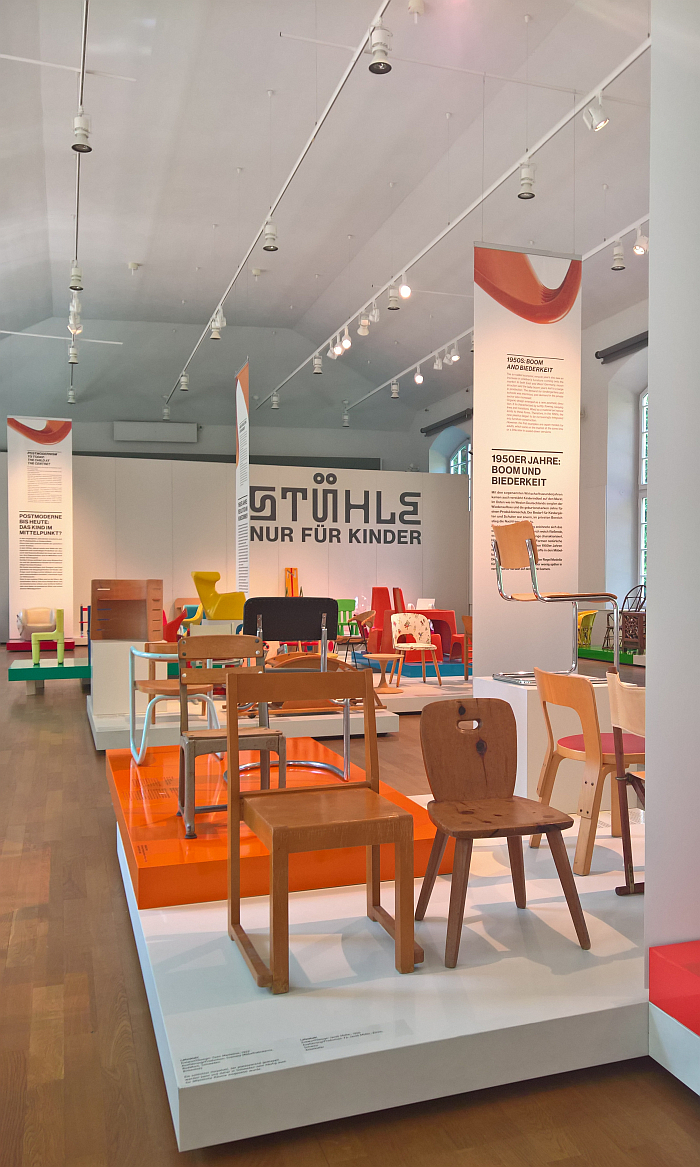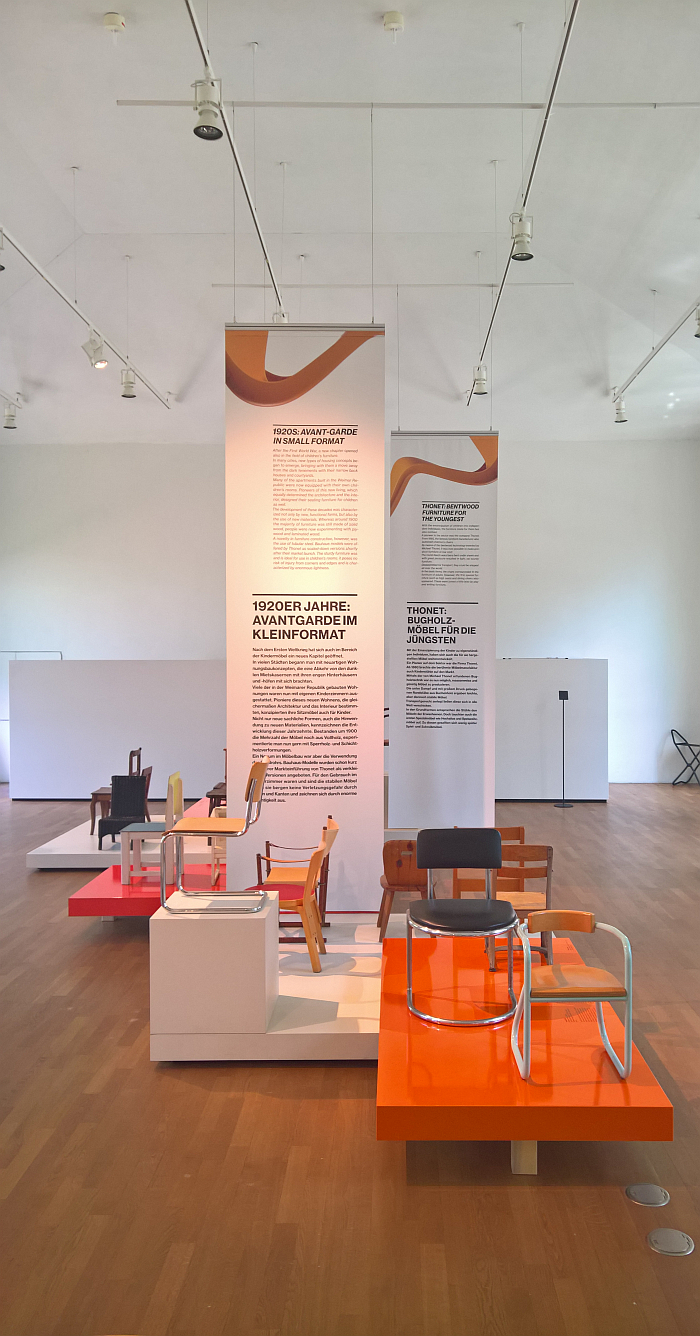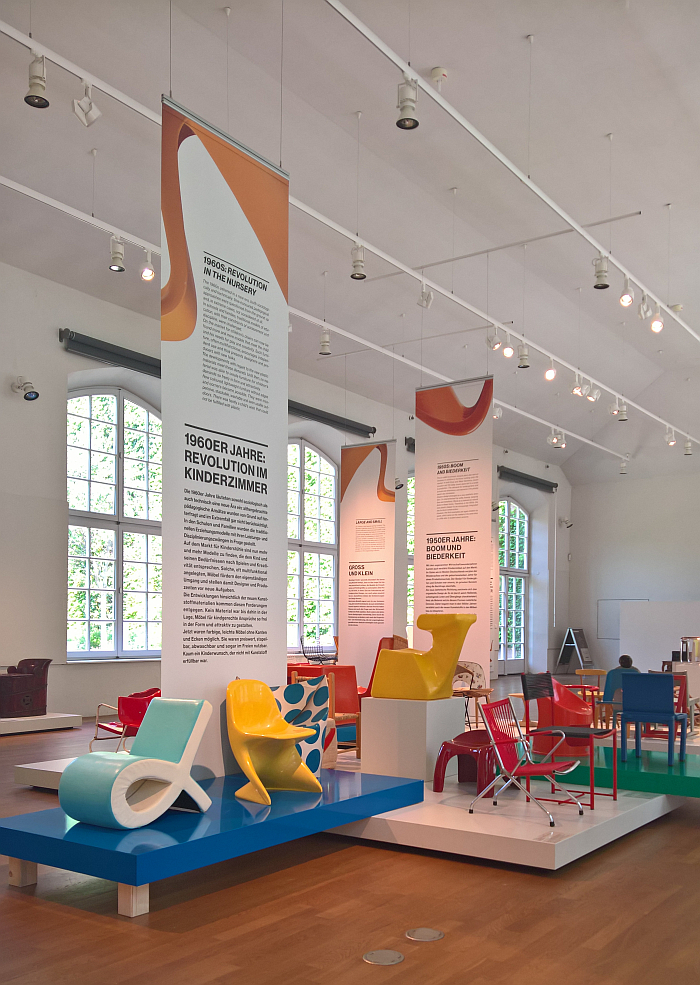What is a chair?
You sure?
With the exhibition Chairs. For children only! the Grassi Museum für Angewandte Kunst, Leipzig, explore the (hi)story of and developments in children's seating, and in doing so not only allow for insights into an all too often undervalued, underappreciated, ignored, genre of furniture, but also forces you to reconsider your response to what you thought was a very, very straightforward question...
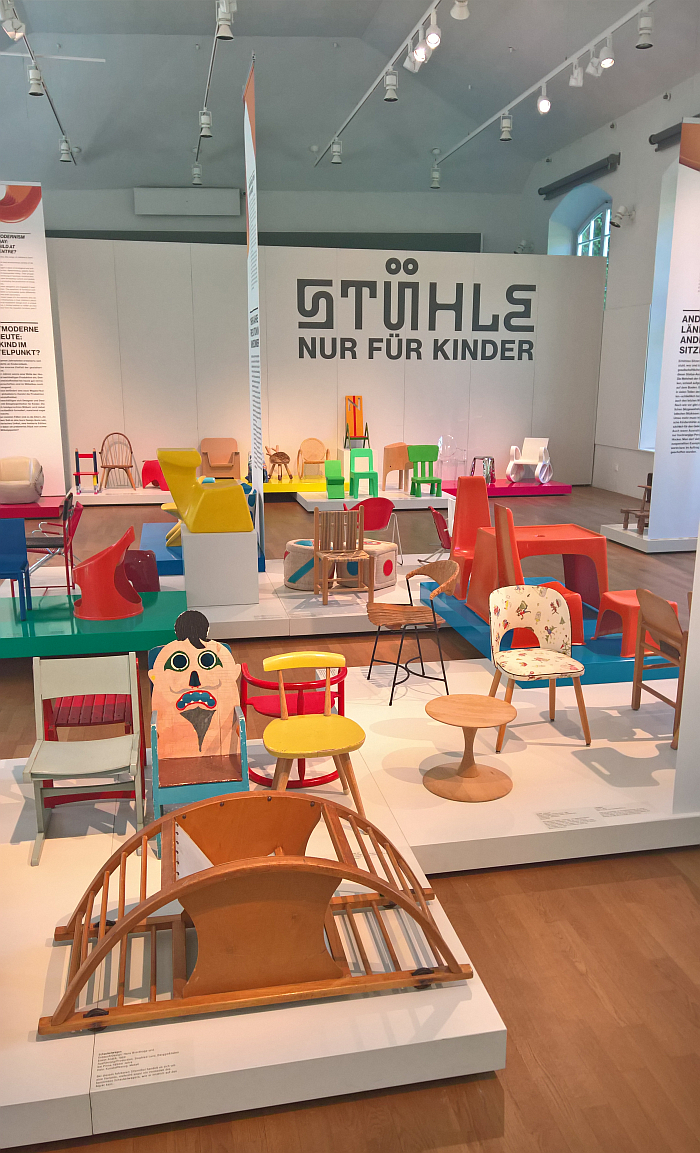
Although throughout (hi)story children have sat, for the greater part of that (hi)story the greater many sat on furniture built for adults; of which children were long considered to be but smaller versions. Children, as understood today, not existing in (European) society for many, many centuries.
And then in the course of the later 19th century children began, when at first only very, very, slowly, to appear in (European) society, began to establish their own, particular, place in (European) society, and as they did chairs, when at first only very, very, slowly, began to be developed and designed specifically for the particular needs and demands of children. And for all for the particular scale of children.
The latter being neatly demonstrated by a trio of late-19th century Thonet children's chairs which greet the visitor to For children only!, and which not only count amongst the earliest commercially produced children's chairs, but which, alongside numerous other, commercial and anonymous, works from the late-19th/early-20th century, help elucidate that the earliest children's chairs were but reduced, scaled-down, versions of adults chairs, responded to the size difference between children and adults without addressing the other particularities. As with adult furniture at that period, if form was following function, then only a very narrow, strict, unreflected, definition of function.
That however would change.
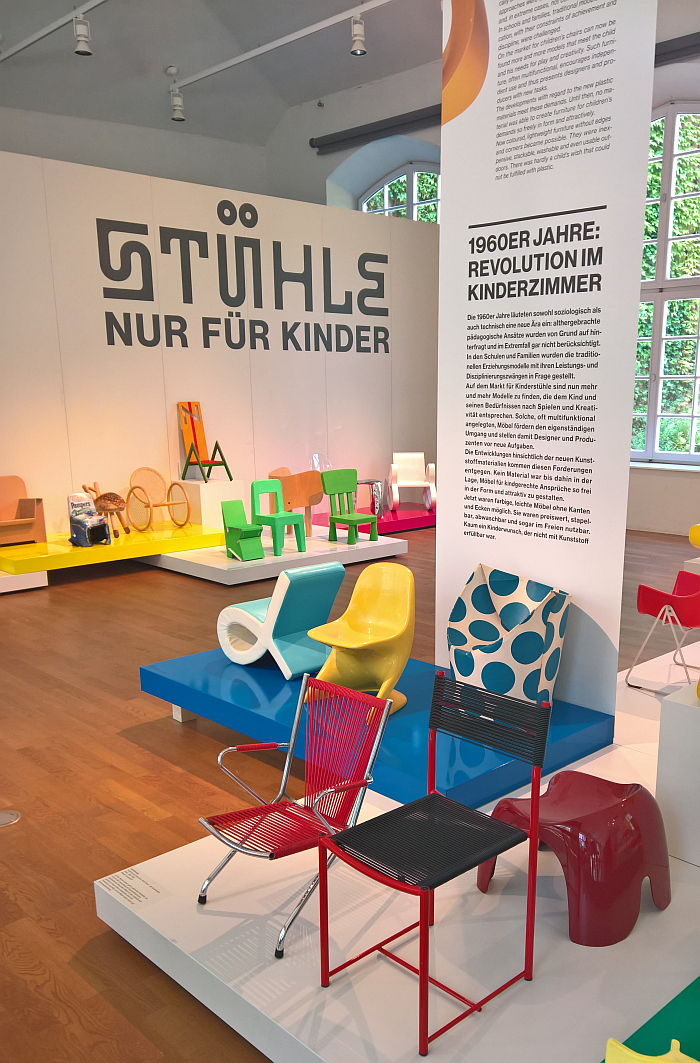
Based on and around a collection, although technically it's not a collection, but we'll get to that, of some 400 children's chairs belonging to Gisela Neuwald, For children only! traces the evolution and development of children's seating from the late-19th century until our present day in a largely chronological narrative: from the late-19th/early-20th century For children only! follows a path over 1920s Modernism, 1950s post-War economic boom, 1960s post-War rebellion, 1970s ecology and sociology, 1980s Postmodernism and ever further onwards into the 21st century
A path which thus moves over epochs and periods of the 20th century familiar to all, but which when approached through the conduit of children's chairs can be viewed from alternative perspectives; for all from a child's perspective. Something that adults do all too infrequently, but which as For children only! admonishes, we should do more regularly, can be a rewarding undertaking.
A path which helps elucidate that as (European) society moved through the 20th century and understandings of children evolved so to did the functionalities associated with children's chairs, the focus moving away from purely allowing a child to be seated to simply allowing a child to be a child. An evolution in tune with the developments in materials and construction principles of adult chairs, but otherwise an evolution very much of its own, an independent evolution indicative of the very real differences between adults and children.
A path which makes short detours to subjects such as high-chairs, of which, as the curator's note, the earliest examples may have been primarily about easing the feeding of children, about easing adults access to the child, form following function, and which later were designed specifically to allow children to sit at the table with adults/elder siblings, form still following function; or subjects such as school seating, if one so will office seating for kids, and which is charted from the fixed desk/bench combinations of yesteryear to more contemporary individual school chairs and thus reflective not only of changes in education practice but also in the realities of the operation and management of schools as education became increasingly mass, and thus the need for chairs that actively assisted the operation and management of large schools, an evolution of the function of school chairs reflected in evolutions of form.
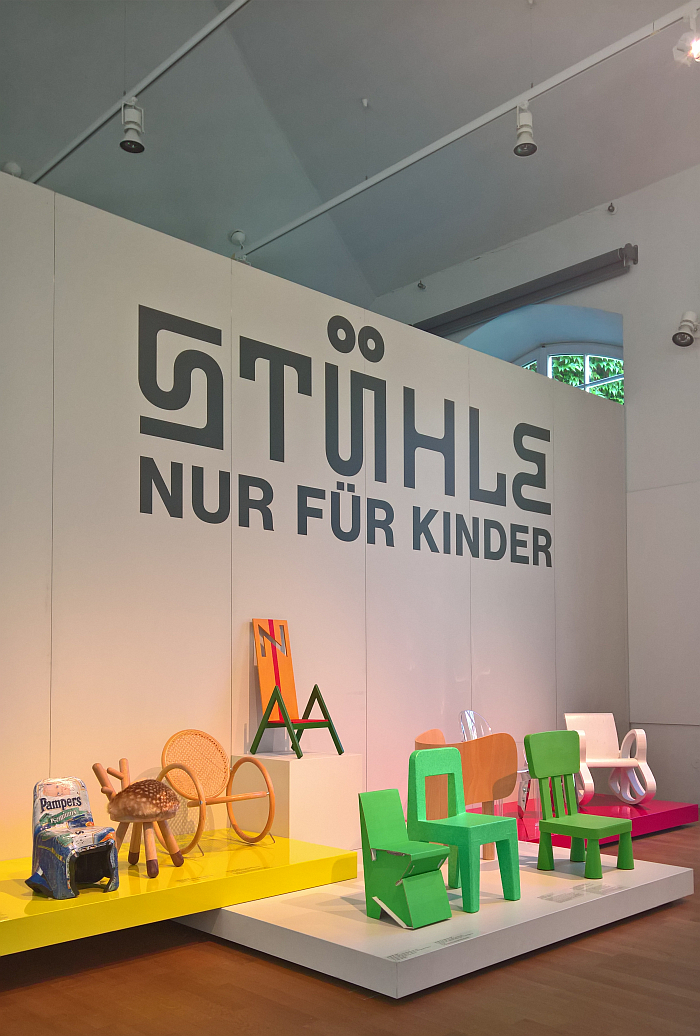
And a path which doubles back on itself to the origins of children's chairs as smaller versions of adult chairs, or more accurately repeatedly doubles back on itself to the origins of children's chairs as smaller versions of adult chairs: in addition to a direct comparison of adult and child versions of chairs by the likes of Arne Jacobsen, Egon Eiermann or Verner Panton one finds scattered throughout the exhibition children's versions of adult chairs by, and amongst many others, Mart Stam, Mogens Koch, Giandomenico Belotti or Robin Day, and which for the curator's pose the question if one can simply do such? Can one simply reduce an adult chair to a child's scale? And for all does reducing a chair down from adult size to child size compromise the formal composition of the work? For whatever else a chair is and may be, a chair is always an interplay of proportions, relationships and perspectives.
The direct comparison of adult/children's chairs allowing an opportunity to reflect on such, to consider the adult and child versions as works in their own right but primarily in context of each other.
And also to question, is a chair designed for an adult automatically suitable, appropriate, for a child?
In the late 19th century Thonet, arguably, could do no other than reduce the scale of their existing chairs, understandings of the concept of "child" being, at that time, not advanced enough to enable, to allow, an alternative approach; today they are, and which very naturally leads on to the question, why are today adult chair designs reduced to children's scales? And for all, why primarily certain popularly known adult chair designs? One could argue, could contest, connote, that it is form following function, specifically that function of furniture as a semiotic tool via which we stage our place in society, via which we confirm to others that we are fully au fait with particular social and cultural understandings, which define the "style" we wish to be understood in context of, our tribal associations. That functionality of looking good on Instagram.
Yet as For children only! leads one to appreciate, not only need it not be so, but arguably shouldn't be so. That with contemporary understandings of "child", one can, should, must, develop chairs for children whose form follows not the functional demands of adults nor of adult society, but which follows the specific, particular, functional demands of children: demands for fun, for interaction, for responsiveness, colour, fantasy, assurance, tactility, friendship, novelty, adventure, belonging, play et al. A world without adults and their rules, nos, prejudices and semiotic tools.
And a world without the problems adults cause.
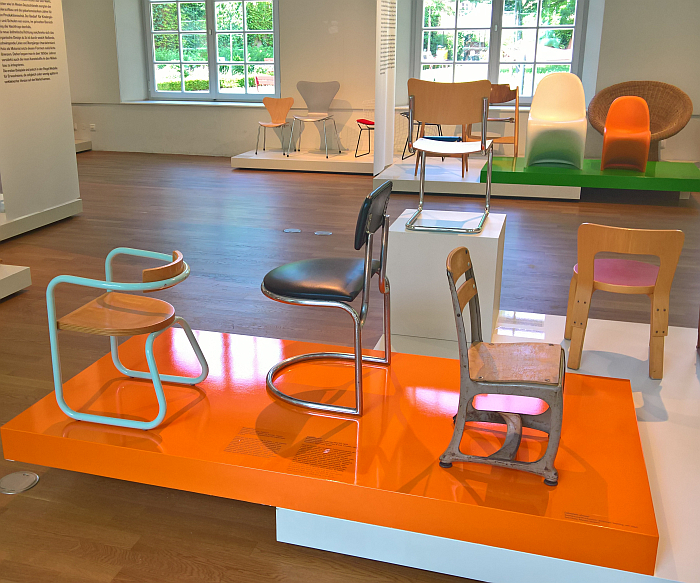
On account of the focus on children's chairs, and the thereby automatically arising reflections on the world of children and on the concept "child", walking through For children only! one is acutely aware that that which is presented is not only a predominately European, Eurocentric, understanding of the 20th century, and thus a predominately European, Eurocentric, understanding of the evolution of the place of the child in 20th century society; but for all represents a privileged perspective, represents an ideal of the relationship between children and society that far too many children both within and outwith Europe never knew or enjoyed, don't know or enjoy.
For a great many children globally childhood is something others have. Poverty, war, patriarchy and similar misconditions that global society really should have moved on from by now, denying them one.
Thus for all the interesting, informative and highly entertaining, insights into seating and furniture (hi)story afforded by For children only!, as an exhibition it is also an important reminder of the inequality inherent in 21st century global society. And being such implores us all to do our bit to work towards a future in which every child enjoys a childhood; a future in which every child perhaps isn't familiar with the actual chairs on show in For children only!, but are familiar with the child specific, child particular, functionalities of a child's chair.
Functionalities particular to children and childhood but which, as many of the works on show indicate, adults can learn from. Should learn from. Something perhaps most elegantly elucidated by Luigi Colani's Zocker for Kinderlübke, a work that was subsequently scaled-up to an adult object; an enlarged form in which the playfulness of the freely interpretive approach to using it defined by its response to the particular needs and demands of children, not only forces one to break from blithely accepted conventions, physical and conceptual, but encourages a freedom of movement that precludes a stiffness in sitting, with all its associated dangers.
And precludes a stiffness in adulthood. With all its associated dangers.
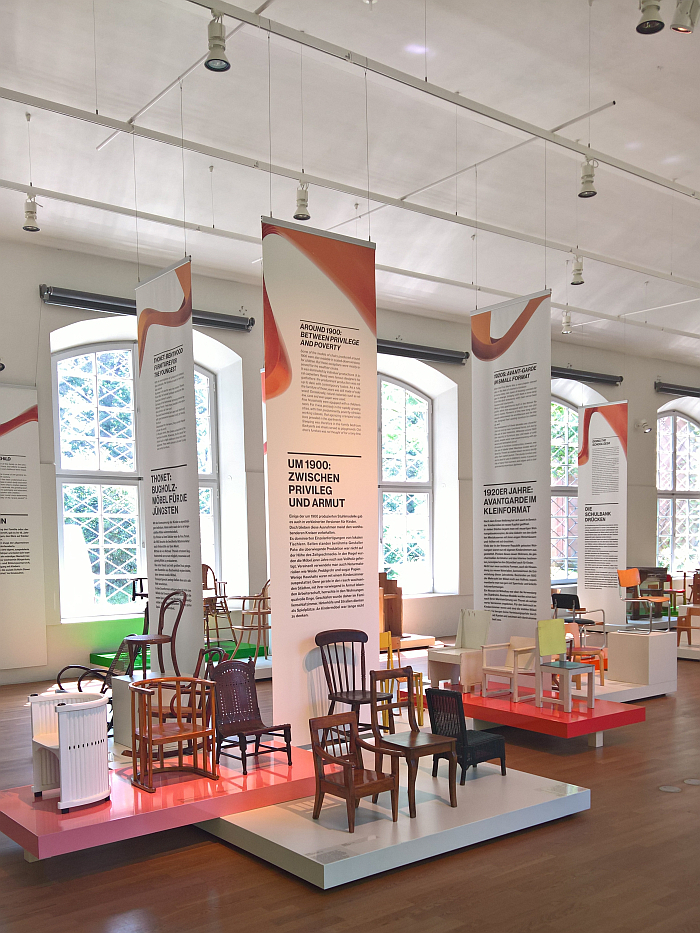
Gisela Neuwald is very precise that her collection isn't a collection, isn't a Sammlung, rather is an Ansammlung, an accumulation, a congregation, a mass that over time has accrued naturally and of its own accord rather than being methodically and purposefully established. Was, as she notes, something she had to be told she was in possession of, she herself not noticing it. And for all is an Ansammlung that lives with family Neuwald in their home, an Ansammlung integrated into home life, first with the Neuwald's own children, now with their grandchildren; and an Ansammlung not for children only, rather one Gisela Neuwald employs herself on a daily basis, not just for sitting on, but for all manner of mundane tasks and in all manner of abstracted functionalities. Is an Ansammlung that is in use.
Or was in use. Now it, or at least a large proportion of it, is in the Grassi Museum für Angewandte Kunst.
On pedestals.
A polarity between its existences which reminds very much of Hella Jongerius and Louise Schouwenberg's arguments in the exhibition Beyond the New at Die Neue Sammlung Munich, that standing on pedestals in a museum furniture is not only denied its raison d'etre, but, as Hella Jongerius explained, "every day things always exist in relation to other things and as soon as you isolate it from its function and social context it becomes an object. And how do you view a thing that has become an object, which has no value as an object?"
A question that is especially pertinent, apposite and omnipresent in For children only! where the particular context of use, demands and functionalities of children's seating make it all too apparent that that which you are viewing is hideously out of context, if there is one item of furniture that shouldn't be isolated on a pedestal it is surely a child's chair. And which thus makes For children only! a pleasing opportunity for considerations on the complexities of viewing furniture in a museum, and of the importance of always being aware of the incongruity between that which you are viewing and what it actually is, was, could still be. And in this case, will once again be after the exhibition is over.
And a question partially answered by the Grassi Museum für Angewandte Kunst through the decision to present half a dozen or so chairs not on pedestals but freely available for use; liberated from the social and functional isolation of a pedestal and gaily insisting that they be sat on, played with, turned upside down, transformed into a spaceship, tripped over, etc...
Something we very much approve of, and something we wish more exhibitions would offer in context of adult chairs. For only through use, through interaction, can one begin to fully understand and appreciate a chair.
Begin to fully understand and appreciate "chair"
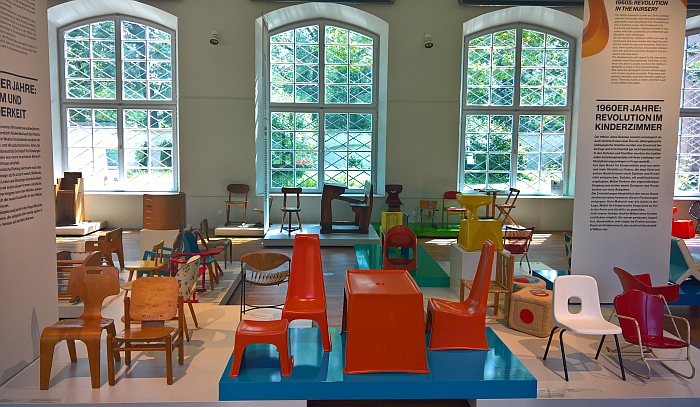
An intelligently compiled exhibition which manages to assemble an outrageous number of chairs in a, relatively, small space without leaving you feeling over-powered, and which also manages to chart and discuss the development of the place and understanding of the child in (European) society without ever feeling like a (hi)story lesson, a particularly pleasing aspect of For children only! is that while the vast majority of the chairs are on pedestals, they are low pedestals; the chairs are presented at a child's height, not an adult's height, meaning adults have to bend and contort themselves, have to get down from their accustomed lofty position, to properly view, to properly comprehend and appreciate that which the child sees. Which, yes, is a very nice analogy. And very nice take-home message.
As pleasing as the low down presentation is the wide variety of chairs on show, a mix of anonymous works and works by internationally renowned designers/architects, a mix of low-end and high-end, a mix of the conceptive and the intuitive, a mix of the delightful and the less so; and for all a mix whose very obvious distance from yet all too undeniable similarity to and parallels with the world of adult chairs underscores that despite the unequivocal title, For children only!, isn't.
Many of the reflections For children only! allows and enables are also very much of relevance for adult furniture, reflections which allow for differentiated perspectives on our relationships with furniture, on the role of furniture, on the necessity of furniture, on the functionality of furniture, on the functionalities of furniture, and that function is always relative to context, and that while the form may or may not, can but must not, follow function, that function must first be defined... a definition that can, does, change as society develops and evolves, leading to evolutions and developments in furniture and thus enabling furniture to serve as a reliable recorder of a given society's evolution and development.
And reflections that allow one to better appreciate that while, yes, a chair is for sitting, it isn't just, that a chair is...?
Chairs. For children only! is scheduled to run at the Grassi Museum für Angewandte Kunst, Johannisplatz 5–11, 04103 Leipzig until Sunday October 3rd.
Parallel the Grassi Museum für Angewandte Kunst is also showing Cultural Affairs. Art without Borders.
Further information can be found at www.grassimak.de
And as ever in these times, if you are planning visiting any exhibition please familiarise yourself in advance with the current ticketing, entry, safety, hygiene, cloakroom, etc rules and systems. And during your visit please stay safe, stay responsible, and above all, stay curious……
